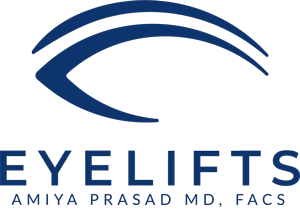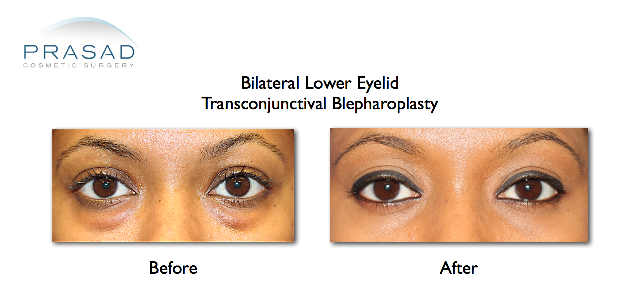Ethnic Eye Plastic Surgery
Considerations for Darker Skin
Dark skin has significantly more melanin than lighter skin, thus providing the added benefit of greater sun protection and less wrinkling. However, darker-skinned people must be aware that certain incisions done to their skin heal differently. There is a tendency for darker skin to form keloids, which are scars that are thick and large. These large scars are seen behind the earlobes of some people after they get their ears pierced. Some of these types of scars can continue to grow and thicken if left untreated.
African-American Blepharoplasty: A Modern, No-Scar Approach
Fortunately, people with darkly pigmented skin are ideal candidates for a type of ethnic eye plastic surgery called transconjunctival blepharoplasty, wherein the incision is created on the inside of the eyelid so that there are no outside scars visible after the procedure. Oculoplastic surgeon Dr. Amiya Prasad favors this type of procedure because the shape of the eye is preserved better and also reduces trauma to the fragile support network surrounding the eye. Dr. Prasad uses very fine instruments, lasers and radio frequency wave procedures to minimize the risk of keloids after ethnic eye plastic surgery. Fortunately, keloids are very rare in correctly performed ethnic eye plastic surgery.
Dr. Amiya Prasad: An Expert in Ethnic Eye Plastic Surgery
Oculoplastic surgeon Dr. Amiya Prasad has been featured in several magazines and web sites focused on the unique needs of non-Caucasian cosmetic surgery patients, including World Journal and Chinese World TV. He has also made an appearance on Good Morning America wherein he demonstrated his surgical techniques and offered a commentary on the globalization of beauty.
For more information on ethnic eye plastic surgery for darker-skinned people, as well as Dr. Prasad’s general eyelift procedure, please visit our eye surgery video gallery.
Before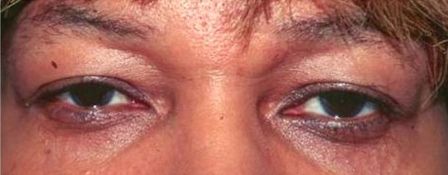 |
After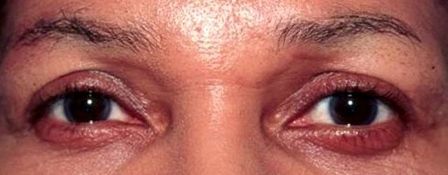 |
This 38-year old African-American woman was concerned that the heaviness of her upper eyelids made her look angry. She was very concerned about the possibility of having keloids from surgery. Dr. Prasad, who is very experienced with most ethnic skin types, performed a bilateral upper eyelid blepharoplasty using sutures and a suturing technique to minimize potential scars. She was very happy to have her eyes more open and appear more friendly.
Before |
After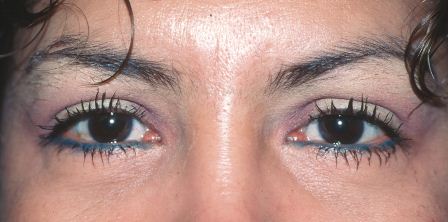 |
This 28-year old woman who traveled from the Dominican Republic complained that she was tired of looking tired. She had tried lotions and potions from all over the world, spending as much as $400 for a vial of “serum”. Dr. Prasad explained that her puffiness was due to fat around her eyes that had pushed forward. She successfully underwent bilateral lower eyelid transconjunctival blepharoplasty at the office operating facility under local anesthesia. She returned home feeling her eyes were brighter and more attractive.
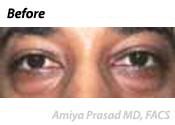 |
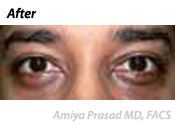 |
This 37-year old African-American male was frustrated with people teasing him for having bags under his eyes. He stated that no matter how much sleep he had, he still could not get rid of the bags. He was planning to get married within a year and wanted to look good for his wedding pictures. He underwent bilateral lower eyelid transconjunctival blepharoplasty which left him no external scars. He was very happy with the results.
Before |
After |
This 57-year old Korean man was concerned that his upper eyelids were starting to effect his ability to see. He had deferred having upper eyelid surgery for many years, in fear that he would look “westernized”. Dr. Prasad, who has extensive experience with Asian eyelid surgery, assured him that he would see better and look natural. He underwent bilateral upper eyelid Asian blepharoplasty and was very happy with the results.
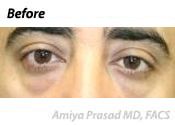 |
 |
This 37-year old man travels extensively for business. It was important to him to have his surgery look natural and not interrupt his work. He had his lower eyelid transconjunctival blepharoplasty on Thursday and was able to fly out for business by Sunday.
Ethnic Blepharoplasty in New York
Many individuals are choosing Dr. Prasad for specialized ethnic eye cosmetic surgery, recognizing his expertise in understanding and addressing the unique anatomical nuances of different ethnic backgrounds.
If you are considering ethnic eyelid surgery and would like to learn more about the procedures offered by Dr. Prasad, we encourage you to reach out to us. You can easily send us a message by completing the form below.
Our dedicated team is also available to answer your questions and provide detailed information via phone at our conveniently located offices in Manhattan, New York City, and Garden City, Long Island.
To ensure you receive the most personalized and effective treatment plan, we highly recommend scheduling a personal evaluation with Dr. Amiya Prasad, a highly respected New York eyelid surgery specialist and Oculofacial plastic surgeon. During a comprehensive consultation, Dr. Prasad will carefully assess your individual needs and discuss the most appropriate procedure or combination of procedures to achieve your desired cosmetic goals.
Post Reviewed by: Dr. Amiya Prasad
